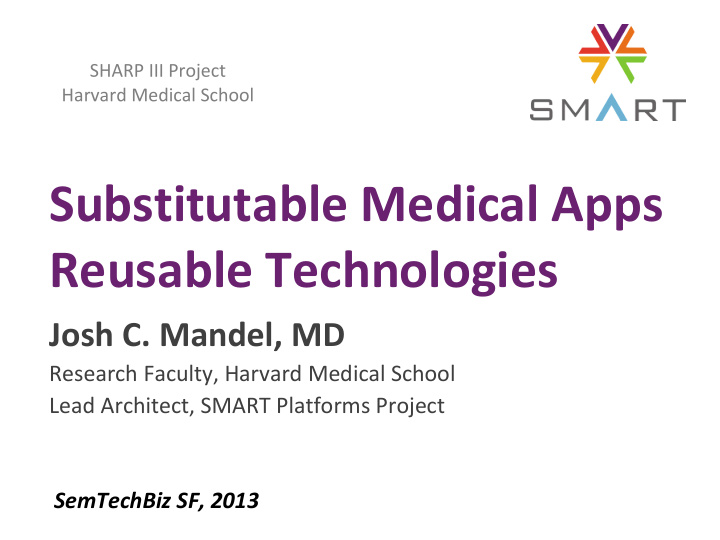



SHARP III Project Harvard Medical School Substitutable Medical Apps Reusable Technologies Josh C. Mandel, MD Research Faculty, Harvard Medical School Lead Architect, SMART Platforms Project SemTechBiz SF, 2013
Substitutable Apps need UI Standards-based integration (HTML5) Data Context (container, user, patient) Medical (Problems, Allergies, etc.) API Resource oriented, everything gets a URL Authentication Consistent delegation with Web standards (OAuth)
SMART Ecosystem Apps Blood Pressure Got Cardiac Statins? Risk API (RDF) SMART-Enabled SMART-Enabled PCHR EMR SMART-Enabled HIE Containers
Substitutable Apps need Data context, medical data
Substitutable Apps need Data information exchange (e.g. CCD) vs. discrete normalized data elements ✓
Substitutable Apps need Data “The best way to manage and store data for advanced data-analytical techniques is to break data down into the smallest individual pieces that make sense to exchange or aggregate.” —PCAST Report on Health IT
Substitutable Apps need Data leveraging standard terminology … simplifies our own models (SNOMED CT, RxNorm, LOINC … )
SMART data models 80/20 approach e.g., concentrate on common outpatient data Specify payloads in standard medical nomenclatures e.g., SNOMED Extensible semantic representations in RDF Ideal for iterative construction over time
Three SMART examples Got Statins? Bioontology SPARQL queries) Pediatric Growth Charts
Backup slides … 24 January 2012 www. smartplatforms.org
Data principles Translate local codes into medical nomenclature (keeping provenance) Medications: RxNorm (SCD, SBD, Packs) Problems: SNOMED CT Labs: LOINC
Clinical summary data models Allergy Immunization Allergy Exclusion Lab Result Demographics Medication Encounter Problem Fulfillment Vital Signs
SMART data model example A Problem instance (SMART RDF) SNOMED CT <sp:Problem> <sp:problemName> <sp:CodedValue> <sp:code rdf:resource=" http://purl.bioontology. org/ontology/SNOMEDCT/161891005 "/> <dcterms:title>Backache (finding)</dcterms:title> </sp:CodedValue> </sp:problemName> <sp:onset>2007-06-12</sp:onset> <sp:resolution>2007-08-01</sp:resolution> </sp:Problem>
SMART data model example A Lab Result instance (SMART RDF) C N I O <sp:labName> L <sp:CodedValue> <sp:code rdf:resource=" http://purl.bioontology.org/ontology/LNC/2951-2 "/> <dcterms:title>Serum sodium</dcterms:title> l a c o <sp:codeProvenance> L <sp:CodeProvenance> <sp:sourceCode rdf:resource=" http://local-emr/labcodes/01234 " /> <dcterms:title>Random blood sodium level</dcterms:title> <sp:translationFidelity rdf:resource="http://smartplatforms.org/terms/code/ fidelity#automated " /> </sp:CodeProvenance> </sp:codeProvenance> </sp:CodedValue> </sp:labName>
Recommend
More recommend